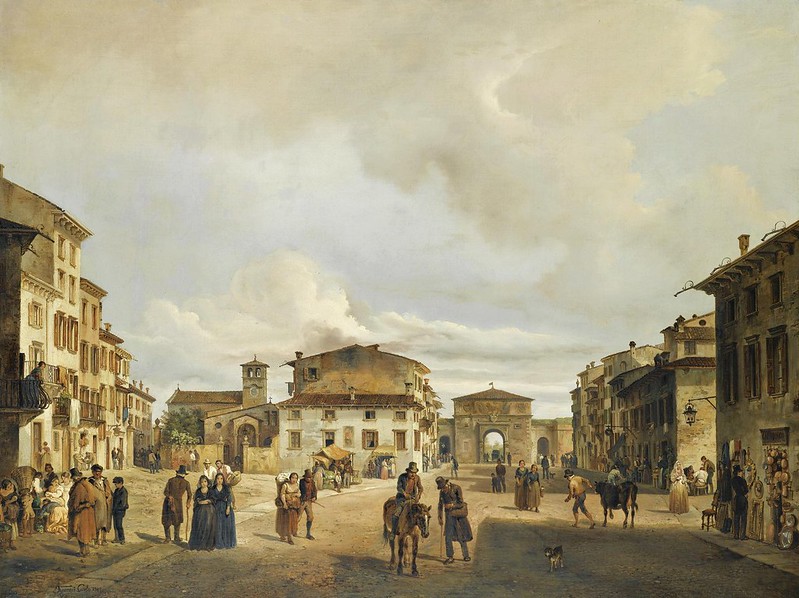Giuseppe Gazzaniga (1743-1818)
- Ouverture 'Susanna' (1787)
Performers: Orchestra Città di Verona; Enrico De Mori (conductor)
Further info: Giuseppe Gazzaniga (1743-1818) - Gloria in excelsis deo
---
Italian composer. His father intended him for the priesthood, but he
studied music secretly and after his father’s death devoted himself to
it entirely. In 1760 he went to Venice to study with Porpora, who
encouraged Gazzaniga to accompany him to Naples. There Porpora obtained a
free place for his young pupil at the Conservatorio di S Onofrio in
Capuana for six years. During this time Gazzaniga studied composition
and counterpoint with his patron. In 1767 he became a composition pupil
of Piccinni, with whom he studied for three years; a year later he made
his début with his comic intermezzo Il barone di Trocchia in Naples. In
1770 he returned to Venice; there he made friends with Sacchini, whose
generous advice was of great benefit to him in his compositions. In the
1770s Gazzaniga wrote operas for various Italian theatres. In 1780 he
was again in Naples, where he directed the revival of Jommelli’s Armida
abbandonata at the Teatro S Carlo and in the following year revived his
own Antigono. His Il finto cieco, on a libretto by Da Ponte, was
performed at the Burgtheater, Vienna, in 1786 and brought Gazzaniga
commissions from Italy, Germany and England; but Da Ponte in his memoirs
had little to say in his favour. Gazzaniga achieved widespread acclaim
with his one-act Don Giovanni, o sia Il convitato di pietra to a
libretto by Bertati (1787, Venice), later also known as Don Giovanni
Tenorio. The work was performed not only in Italy, but also in Paris
(1792), Lisbon (1792) and London (1794); Kunze has recorded no fewer
than 32 editions of the libretto up to 1821. Though Bertati’s text was
decisive in Da Ponte’s own Don Giovanni for Mozart, it is unclear
whether Mozart had studied Gazzaniga’s score; his letters say nothing of
Gazzaniga’s opera, and no Viennese performance of the work is known,
though he may have encountered Gazzaniga’s music through his Ottavio,
Antonio Baglioni, who had been Gazzaniga’s Giovanni in Venice.
Four years after the Venice première Gazzaniga accepted an appointment
as maestro di cappella at Crema Cathedral, and subsequently composed few
dramatic works. Little is known of the composer’s final years, though
letters and documents mention responsibilities beyond the cathedral and
allude to economic hardship. Stefano Pavesi, who was his pupil from
1802, succeeded Gazzaniga as maestro di cappella following the latter’s
death from colic in 1818. Gazzaniga belongs to the last generation of
Italian buffa composers whose most brilliant representatives, Paisiello
and Cimarosa, provide a link with the comic opera of Rossini. His music
typifies the late 18th-century opera buffa style. It is less rich in
harmony and texture than Paisiello’s, but nevertheless closer to the
combination of conciseness and judiciously applied sentiment of
Paisiello than to the extravagant comic prolixity of Cimarosa.
Gazzaniga’s style tends to be concise and relatively thin in texture,
emphasizing the forward motion of the music as well as the declamation
of the text. He seems to have been less tied to symmetrical groups of
two and four bars than some of his contemporaries, and interesting
rhythmic or melodic details often make up for rather basic harmonies and
lean textures. One of the more striking aspects of Gazzaniga’s music
for his opere buffe is its expressive clarity; there is never any doubt
about the emotional content or the type of character singing. Though
sometimes predictable he often avoided dullness with witty details that
enhance the dramatic situation. Gazzaniga was not well educated, but a
letter to Simon Mayr shows that he took an interest in older masters as
well as in contemporary music, and that he possessed a substantial
library.

Cap comentari:
Publica un comentari a l'entrada